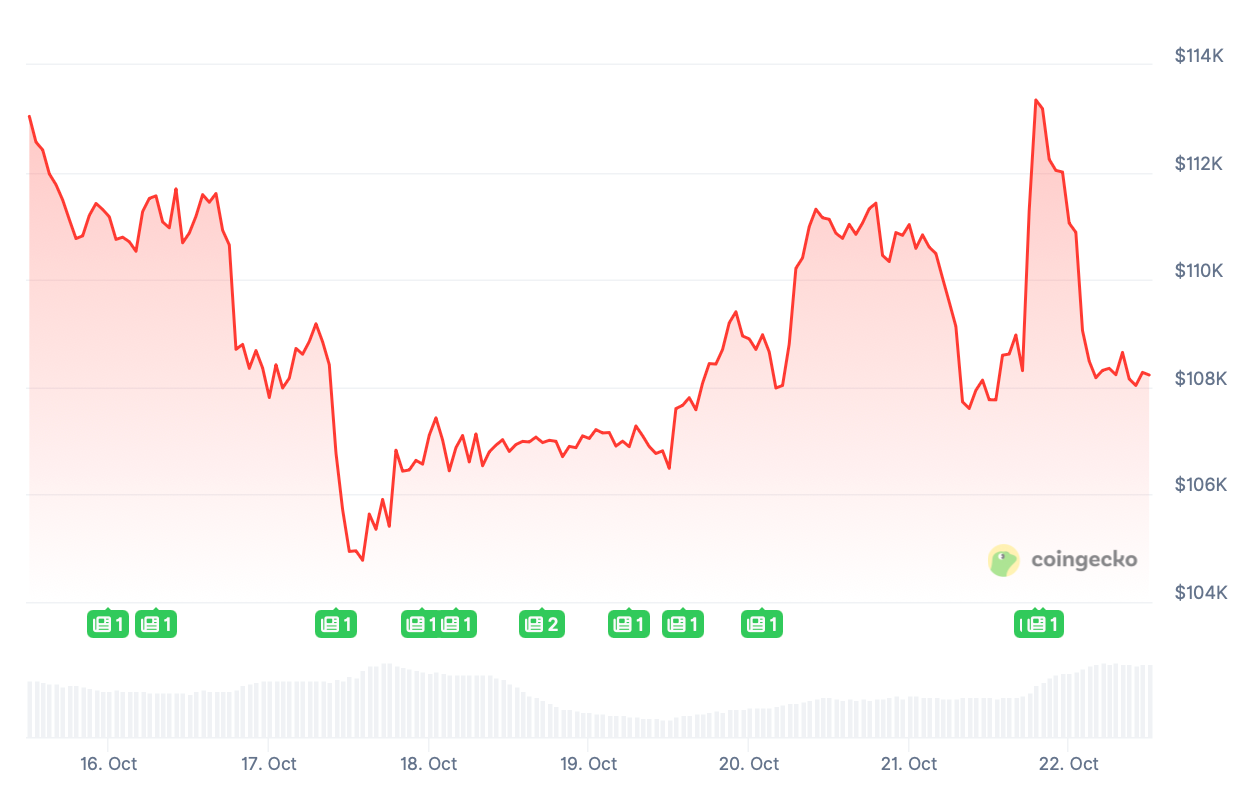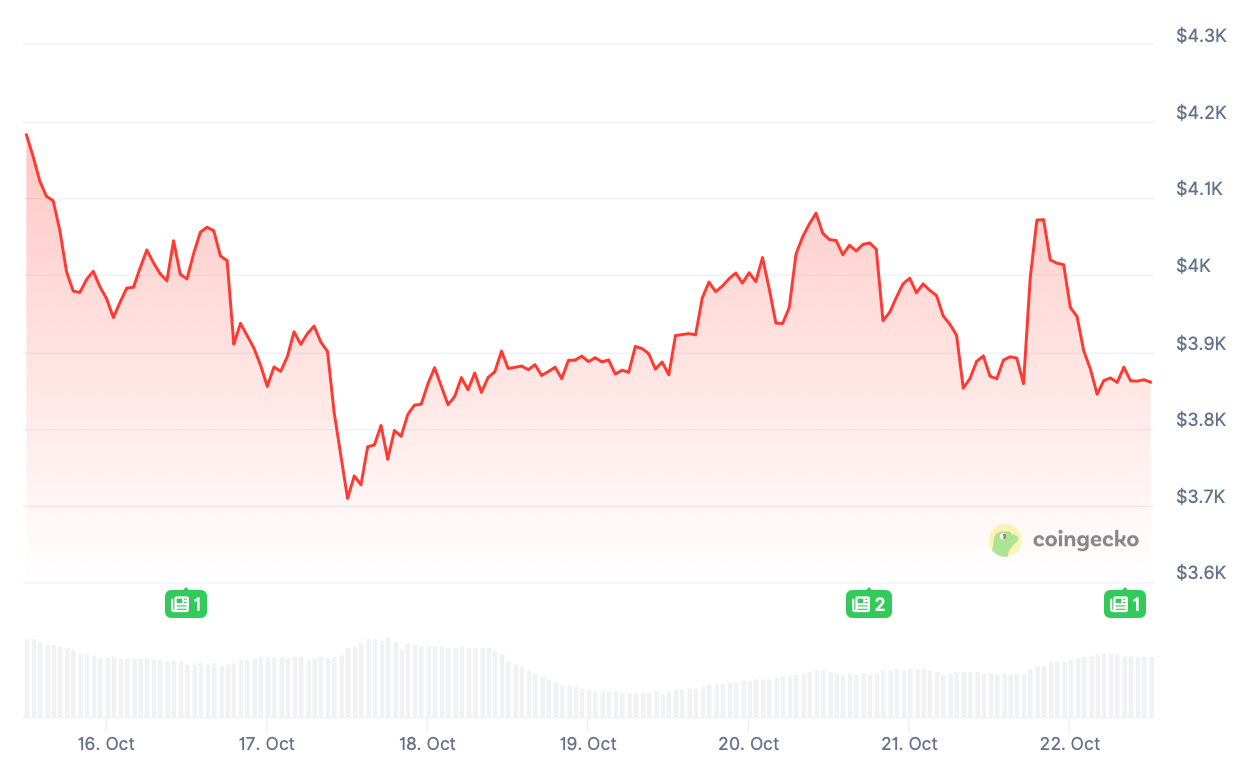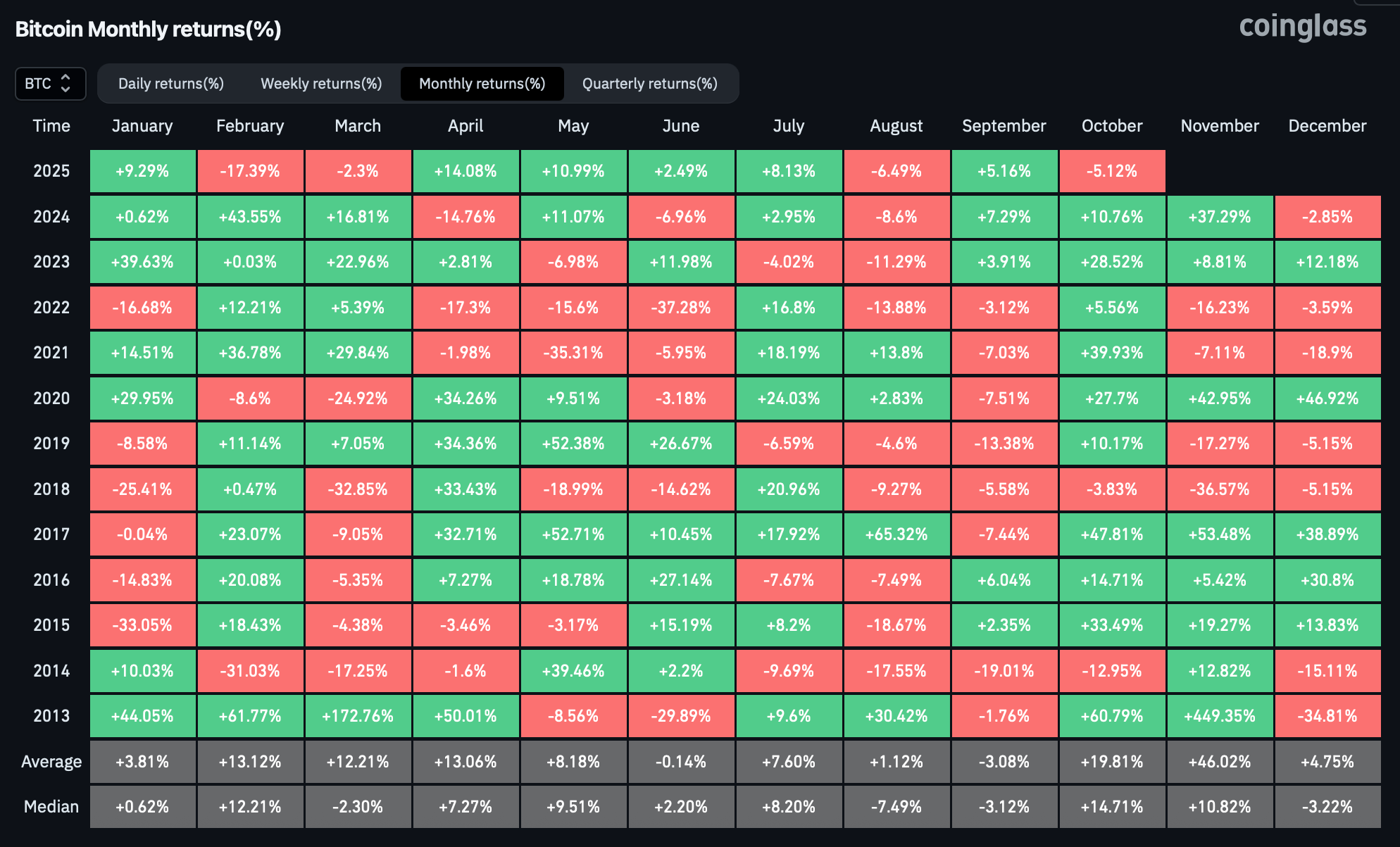Clapp Weekly: Faltering Uptober, Fed's crypto shift, Ethereum's civil war

BTC price
Bitcoin is cooling off after surging to $113k, following a steep Tuesday selloff in precious metals. Futures are recovering, but spot ETFs are still feeling the effects of last week's second-worst outflow on record (-$1.23 billion). Meanwhile, Citi has given Strategy a buy/high-risk rating, calling it a leveraged bet on BTC.
Slipping from $113,423, BTC crashed to $104,778 on Friday, October 17, and stayed in a tight range around $107k through the weekend before pushing higher. It rose past $111k on Monday, dipped to below $108k again, and topped out at $113,188 yesterday.

Currently at $108,456, BTC has gained 0.2% over the past 24 hours but lost 4.1% over the past week.
ETH price
Mirroring Bitcoin, ether erased its weekend gains yesterday amid a broad market reversal. The sell-off occurred even as SharpLink Gaming, the second-largest corporate holder, made its first ETH purchase in over a month — a $79 million buy. Meanwhile, ETFs continued bleeding until yesterday, and community tension intensified after a developer rift came to light.
Like BTC, ETH sank from almost $4.2k to $3,709.06 on Friday, October 17, and reversed. It climbed steadily until Monday's high of $4,080.75, then cooled to $3,852.62 before managing another short-lived recovery.

After touching $4k again, ETH is now trading at $3,871.79, down 0.1% over the past 24 hours and 6.0% over the past week.
Seven-day altcoin dynamics
Altcoins temporarily pushed upward on Tuesday, tracking Bitcoin’s brief recovery after a record rally in precious metals reversed course. Gold plunged 5% to $4,130 — its sharpest daily drawdown in years — while silver shed roughly 8%.
Over the past few months, gold and silver have been propelled by three key tailwinds: central banks switching to monetary easing, US-China trade tensions, and signs of liquidity and credit stress. Yet this momentum failed to spill over into crypto, where BTC remained range-bound for months.
Analysts note that sharp intraday swings across BTC, ETH, and major altcoins indicate caution. The market is stuck between institutional optimism and concerns about tightening global liquidity — a natural consequence of the historic liquidation cascade on October 10 (“Black Friday”).
Altcoins are struggling, and repositioning will take time — market observers expect volatility to remain elevated in the near term. The biggest risks for crypto include macro uncertainty and the spillover of the US-China tariff war. Some are wondering if “Uptober” has ended before it even began.

US CPI in the spotlight
This week, the market is bracing for the first inflation print (September CPI on October 24) since the US government shut down on October 1. Analysts expect a moderate reaction—even in case of an upside surprise — as tariff fears and labor data should overshadow price pressures.
At press time, CME FedWatch shows 96.7% confidence in a 25-basis-point cut on October 29. In the aftermath of the “Black Friday” sell-off, US-China tariff and trade policy uncertainty is the key focus for investors.
Meanwhile, users of Polymarket and Kalshi are increasingly betting on a 40-day US government shutdown (around November 15) — which would exceed the 2019 record of 35 days.
Weekly winners
- HASH (+11.9%) climbed steadily through the past week, aside from a flash crash on October 16 when it dipped below $0.03.
- M (+9.5%) demonstrated resilience to market downturns, supported by an active community and strong accumulation as traders anticipate new breakouts.
- ZEC (+7.8%) extended its 750% quarterly gain as governments intensified financial surveillance, driving adoption — HODLers have moved 1 million coins to ZCash's shielded pool in just three weeks, representing 500% growth.
Weekly losers
- ASTER (-29.8%) faced pressure from $326 million in TVL outflows and shrinking trading volume, indicating declining protocol use. Market sentiment switched from bullish to bearish within a week.
- COAI (-26.3%) cooled after its 100x sprint as on-chain scrutiny outweighed euphoria — an investigation revealed a potential central control pattern, with 60 wallets tied to Chain Opera AI that executed thousands of automated trades under nearly identical conditions.
- MNT (-18.4%) sank yesterday after a brief recovery two days prior, as the engagement boost from Bybit campaigns and the ZBT launch pool faded.
Cryptocurrency news
Fed proposes "skinny" master accounts for crypto firms
The US Federal Reserve is considering a new path to payments rails for crypto firms. Governor Christopher Waller has announced that the central bank could launch a new type of limited-access account for innovative payment providers. These "skinny" master accounts would unlock direct access to the Fed's infrastructure.
Speaking at the Fed's Payments Innovation Conference on October 21, Waller stated, "My view from the Fed from now on is embrace the disruption, don't avoid it." Non-traditional entities — like crypto companies — would be eligible even despite the absence of traditional bank privileges.
Waller also stressed that distributed ledgers and crypto are "increasingly woven into the fabric of the payment and financial system."
What a "skinny" account provides — and what it doesn't
With a full master account, banks can use the Fed's payment rails for settlements and access services like interest on balances and emergency lending. In comparison, the proposed "skinny" version would be limited in scope.
- Included: direct access to the Federal Reserve's payment rails, enabling real-time settlements.
- Not included: key banking privileges like paying interest on balances, daylight overdraft protection, or access to the Fed's discount window for borrowing.
- Potential additional limitations: balance caps to control risk to the central bank's balance sheet.
Potential impact on the crypto industry
This development could resolve a major hurdle for crypto-native companies. Firms like Ripple, which has applied for a master account, currently must rely on intermediary banking partners to access the US financial system.
Direct access could significantly streamline operations. Stablecoin issuers, crypto exchanges, and other blockchain-based payment services would all benefit from "skinny" accounts.
Yet not everyone in crypto is impressed. Caitlin Long, founder of Custodia, a Wyoming-chartered crypto bank, cautioned that the devil is in the details. For instance, trust companies that custody crypto assets may not be considered legally eligible, as they are currently unable to receive deposits.

Waller has asked Fed staff to formally explore the idea and has promised that the industry will hear updates shortly. While the plan is not yet finalized, its proposal signals a notable step toward integrating digital asset firms into the core of the American financial landscape.
Internal tensions challenge Ethereum's decentralized ideals
A memo from longtime Ethereum core developer Péter Szilágyi exposes significant internal concerns about the network's governance. Szilágyi, who led the Geth client team until recently, has published his scathing mid-2024 letter to Ethereum Foundation leadership — claiming that a small group effectively controls the entire ecosystem.
"Ethereum may be decentralised, but Vitalik absolutely has complete indirect control over it," Szilágyi wrote. He elaborated that Buterin's "attention, direction of research, brainpower, donations and investments absolutely define which projects succeed (at a very high probability)."
According to the developer, securing approval from "the correct 5–10 people around Vitalik" has become essential for project success within the ecosystem. The full text is available on Github.

Compensation conundrum
Szilágyi's critique extended to the Ethereum Foundation's compensation practices, revealing he earned roughly $625,000 over six years of work with zero benefits or raises. Describing this as "a bad financial decision," he argued that underpaying key contributors created "a perfect breeding ground for perverse incentives, conflicts of interest and eventual protocol capture."
This compensation issue appears to be affecting talent retention. The recent departure of top researcher Dankrad Feist to Tempo — a blockchain project backed by Stripe and Paradigm — follows a similar pattern. A Protocol Guild survey supports these concerns, showing Ethereum core developers earn a median salary of $140,000, below what many established rivals offer.
Ecosystem reactions and implications
The revelations have sparked broader discussion within the Ethereum community. Polygon CEO Sandeep Nailwal responded by questioning why "someone with major contributions to Ethereum has to publicly question what they're even doing here" so frequently.
Meanwhile, Consensys founder Joe Lubin characterized the talent drain to projects like Tempo as part of a pattern where VCs aim to "suck as much value as possible from the Ethereum ecosystem." However, he also noted that corporate chains signal mainstream validation of blockchain technology.
These internal criticisms emerge as Ethereum faces increasing competition from other networks, raising fundamental questions about whether its governance and compensation models can sustain its long-term development goals.



